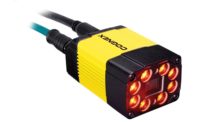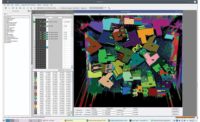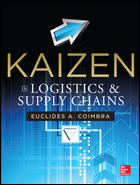
With connectivity over three distinct channels (command, data export and image export), results can be delivered to HMIs and PCs at faster speeds and with greater frequency for unparalleled access to inspection information. Source: Banner Engineering
One way to ensure customer satisfaction is to produce a product that consistently meets consumer demands. With assembly lines moving faster, the margin for error is shrinking and utilizing vision sensing is a vital component to reliable mass-production that steadily delivers a quality product. Designed with enhanced features to improve inspection capabilities, vision sensors provide a wide range of application solutions from simple presence detection to complex pattern recognition-making them an important addition to any manufacturing process.
Vision sensing (or electronic imaging) provides control to manufacturers over multiple processes from machine tools and robots to product quality and inspection. Comprised of a camera, which determines the range of the product features and performance, and a control system that is used to interface the sensors with machine controls, vision sensors allow users to set product specific parameters for inspection. The inspection process consists of the following three-step process:
Acquire: A camera snaps a picture of the part.
Analyze: The picture is transferred to memory where it is processed, analyzed and compared to previously set product parameters.
Determine: Finally, the vision sensor utilizes user-defined tolerances for each parameter to output a pass/fail result for each inspection.
Vision sensors are a superior manufacturing detection tool due to their unparalleled abilities to handle high-speed assembly lines-allowing the sensor to inspect products with 100 percent accuracy in comparison to human inspection capabilities, which at its best, is approximately 80 percent accurate. Additionally, vision sensors are able to conduct simultaneous, repetitive, multiple and consistent inspections on objects (same or differing), providing reliable results for complex detection needs. Their user-friendly, easy-to-install application offers a universal vision solution-delivering cost-effective, powerful vision capabilities for the manufacturing industry.

Ethernet enabled vision sensors deliver remote managing options to provide instantaneous pattern updates or access stored inspections. Source: Banner Engineering
Photoelectric vs. Vision Sensing
Photoelectric and vision sensing are inspection tools used in manufacturing processes. While both use and interpret light (or the absence of it) to control machines and processes for product detection, the differences regarding sensing methods, inspection capabilities and analytical potential are significant. Each sensor is equipped with specific strengths and purposes, providing precise services that meet individual manufacturing needs.Photoelectric sensors produce only one beam of light, which results in only one point for inspection. Therefore, multiple sensors may be needed if a machine or product requires several points of inspection. Photoelectric sensors operate by conducting an analysis of light intensity for determining object detection, triggering the vision sensor when an object’s presence is established. The sensor will give a simple discrete signal, a binary output based on the presence or absence of light. Given photoelectric sensors simplistic detection method, it can be a solution for processes where a mere verification of the presence or absence of an object is desired. For example, users can employ a photoelectric sensor to recognize whether or not a box of cookies is present in a simple inspection application.
Alternatively, vision sensing is not limited to simple presence detection, but can also analyze the color, shape, size or position of an object’s feature. Vision sensors do not rely on the object to trigger inspection, but instead use dedicated light to illuminate and capture the entire image for complete visual feedback. A single vision sensor can inspect multiple points on an object, reducing equipment requirements while gaining expanded range. The vision sensor “sees” an area, and senses many thousands of distinct points (or pixels) in the specified area. Further, users can change the lens of the sensor, making the field of view smaller or larger, to accurately obtain the microscopic level of detail needed. Upon image capture, the vision sensor provides a binary output with enhanced communication capabilities, allowing users to send large amounts of data about an object’s parts or features serially or via computer protocols such as Ethernet. This enables data to be communicated to the entire manufacturing enterprise.
Using the above box of cookies example, a vision sensor is capable of conveying detailed inspection results. Instead of a simple detection of the box, a vision sensor can detect the presence of the box, determine whether any cookies are missing and the orientation of the missing cookies, as they are not always located in the same position. Therefore, a vision sensor is ideal for inspection applications requiring a detailed analysis of features, sizes, shapes or positions.
The increased capabilities of vision sensing provide vast benefits for manufacturing inspection applications with enhanced flexibility of use. Users are able to set inspection parameters to detect specific features, such as the position of a label or verifying that all the teeth of a comb are the same length. Further, the advanced inspection options offered by vision sensors can lead to a reduction in production costs and overhead expenses by eliminating rework, reducing scrap and identifying defects in products early in production before it increases in value.

Vision sensors offer extensive inspection variety and flexibility. Source: Banner Engineering
Advancements in Vision Sensing
Vision sensing technology has continued to advance and adapt, accommodating various production needs and providing enhanced inspection capabilities, for diverse manufacturing applications. These added features are intended to make communication, control and adaptation easier and faster than ever before. New innovations provide vision sensors capable of superior performance coupled with unique features, while remaining simplistic in use.Vision sensors provide an easy to set-up, self-contained solution to inspection challenges-requiring no PC for inspection, configuration or modification. Complete with a camera that acquires up to 100 frames per second, an innovative touch screen, high-resolution images, increased performance processing and adjustable lens for the ideal viewing field, vision sensors are a smart technology that take production inspection to unparalleled heights.
Vision sensors equipped with Ethernet connectivity capabilities can provide effective, immediate communication between sensors and PLCs, PC and other factory devices. Ethernet allows the vision sensors to share information such as images or inspections quickly, providing immediate results. Ethernet enabled vision sensors deliver remote managing options to provide instantaneous pattern updates or access stored inspections. With connectivity over three distinct channels (command, data export and image export), results can be delivered to HMIs and PCs at faster speeds and with greater frequency for unparalleled access to inspection information.
In addition to connectivity developments, vision sensors also have improved inspection technology to enable them to adapt to enhanced manufacturing speeds and complex detection requirements. Vision sensors offer extensive inspection variety and flexibility. Capable of storing an unprecedented 30 inspections at a time, vision sensors can easily accommodate high speed assembly lines and rapid product changeover. Vision sensors offer multiple configuration options, including Area, Blemish, Match and Sort, permitting vision sensors to tackle challenging and intricate inspection needs. Area can be used to identify a particular feature(s), such as quantity or size. Blemish will recognize any potential flaws on the part, such as a scratch on a CD; while the Match configuration is used to verify that shapes or patterns in a part replicate the reference pattern. Lastly, Sort can distinguish between pattern variations, classifying as many as 10 patterns in a single inspection-distinguishing between items like nuts and bolts.
User-friendly installation and configuration is accomplished through a series of menu-driven tools that guide users through selecting specific inspection designations for each product. These sophisticated vision sensors are designed to allow manufacturers to define regions of interest for the inspection, classify and adjust precise tool parameters, and select the minimum and maximum pass count for each inspection. Updating inspection requirements is fast and simple, and can be done remotely using the sensor emulator, which allows offline updates and modifications-preventing production downtime and reducing expenses.
Given the broad range of industries that rely on sensor technology to produce consistent, quality products, vision sensors offer customization options through their expansive application options. Manufacturers can select vision sensors to fit their precise product needs from a diverse range, including sensors that detect feature presence to sensors with capabilities of overseeing the entire assembly process. Other options can include recognizing a feature based on color, date code or size code, location analysis, which orients production through the next assembly step or sensing capabilities that identify features based on shape, color or size.
Vision sensors now offer remote monitoring possibilities in which a remote touch screen is paired with one or more sensors to allow the same innovative inspection capabilities to examine previously un-inspected or difficult-to-monitor areas. Once vision sensors have been set up, users can operate the remote features to configure, monitor and update inspection requirements for all vision sensors- providing a new comprehensiveness to product inspection.
With sensing technology offering a broad spectrum of inspection possibilities, from the simplistic, dependable presence detection capabilities of photoelectric sensors to the complex, analytical deduction abilities of vision sensors, finding the ideal inspection solution for manufacturing has never been easier or more thorough. Understanding a vision sensor’s features and strengths will enable manufacturers to easily match-up machine processes to the right inspection tool-ensuring continued enhancements to production quality and retaining customer satisfaction.V&S
Tech Tips
Vision sensing provides control to manufacturers over multiple processes from machine tools and robots to product quality and inspection.At the Acquire stage, a camera snaps a picture of the part.
At the Analyze stage, the picture is transferred to memory where it is processed, analyzed and compared to previously set product parameters.
At the determine stage, the vision sensor utilizes user-defined tolerances for each parameter to output a pass/fail result for each inspection.


